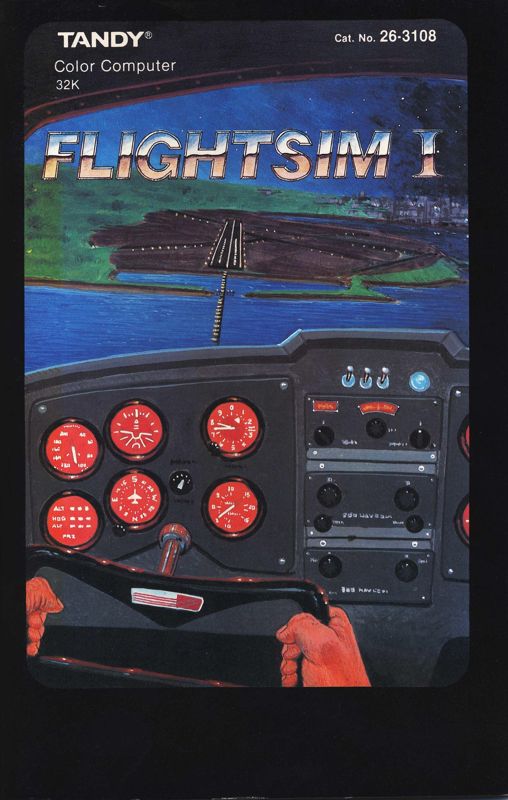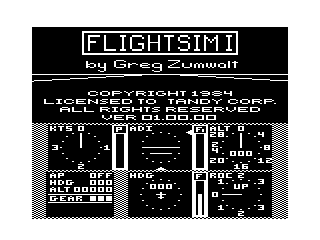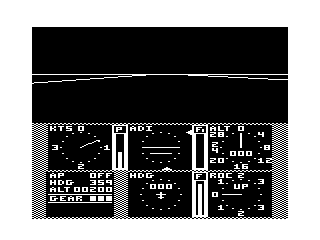Retro Replay Review
Gameplay
FlightSim I places you squarely in the pilot’s seat of a high-performance jet, challenging your ability to master a surprisingly deep control scheme for a TRS-80 Color Computer title. From the moment you power up the simulation, you’re responsible for managing retractable landing gear, full flap settings, and throttle to achieve and maintain your desired cruise altitude and speed. The inclusion of an Auto-Pilot and Glidescope system allows for a rudimentary but satisfying instrument flight experience, letting you focus on navigation and approach techniques.
(HEY YOU!! We hope you enjoy! We try not to run ads. So basically, this is a very expensive hobby running this site. Please consider joining us for updates, forums, and more. Network w/ us to make some cash or friends while retro gaming, and you can win some free retro games for posting. Okay, carry on 👍)
The game world spans roughly 22,185 square miles of simulated terrain, populated by eight different airports and nine notable landmarks. This open-ended environment grants you the freedom to plot your own courses, fly sightseeing tours, or practice precision approaches under varying conditions. Although there are no formal missions or challenge modes, the sheer size of the simulation area and accurate instrument readouts create natural objectives—such as navigating to a distant airfield or executing a perfect landing in low-visibility conditions.
Flight performance feels surprisingly authentic given the platform’s limitations. You’ll notice gradual shifts in speed, altitude, and climb rate as you tweak your throttle lever, and the Attitude Deviation Indicator (ADI) demands constant attention to keep the aircraft properly aligned with your flight path. The lack of modern aids means you must manually cross-check instruments, offering a genuine taste of real-world VFR (Visual Flight Rules) and IFR (Instrument Flight Rules) flying.
While the learning curve can be steep, especially for those new to flight simulators, the game’s intuitive controls and clear instrument panel help flatten initial frustrations. Veteran sim pilots will appreciate the straightforward yet challenging mechanics, which reward careful planning and disciplined cockpit management.
Graphics
FlightSim I leverages the TRS-80 Color Computer’s graphics capabilities to render a minimalist wireframe environment. Runways, horizon lines, and landmarks are drawn with simple vector lines, and while the visuals may appear sparse by today’s standards, they convey vital flight information with clarity. The cockpit instruments themselves are neatly organized, with crisp alphanumeric readouts for altitude, speed, and rate of climb.
The game’s color palette is deliberately restrained, using contrasting hues to distinguish critical elements such as the horizon line, runway edges, and airport beacons. This approach maximizes legibility at the expense of realism, but it ensures that you can quickly interpret the visual data even when flying at high speeds of up to 375 knots (432 mph).
Landmarks and airports are represented by simple geometric shapes, yet each location is instantly recognizable due to thoughtful placement and scale. Whether you’re approaching a city skyline or a rural airstrip, the level of detail remains consistent, helping you orient yourself within the expansive simulation area.
Although there are no advanced graphical effects like terrain shading or weather overlays, FlightSim I’s visuals serve the primary purpose of a flight simulator: providing essential cues for navigation and aircraft control. For a late-1970s home computer title, the graphics strike a commendable balance between function and immersion.
Story
FlightSim I does not offer a traditional narrative or campaign structure; instead, it invites you to craft your own aviation stories. You can imagine yourself as a test pilot evaluating cutting-edge jet performance, an airline captain logging hours between remote airstrips, or an adventure-seeker mapping out a cross-country tour of landmarks.
The absence of scripted missions places the emphasis firmly on the simulation itself. Rather than following a linear story, you define success by adherence to flight plans, smooth landings, and efficient use of autopilot and glidescope features. This sandbox-style approach encourages exploration and experimentation, letting you test your piloting skills against the backdrop of a realistic, if abstract, flight environment.
Instructional text and in-game readouts serve as your co-pilot, guiding you through instrument procedures and approach protocols. While there is no voiced narration or cutscenes, the manual and on-screen prompts provide sufficient context to immerse yourself in the role of a professional aviator.
For players seeking a narrative-driven adventure, the lack of story beats may feel sparse. Yet for aviation enthusiasts and simulation purists, the open-ended format becomes a canvas for personal achievement and discovery, creating memorable moments through skillful flying rather than plot twists.
Overall Experience
FlightSim I delivers an impressively authentic and educational flight simulation on hardware that most would consider severely limited by modern standards. Its focus on instrument flying, realistic jet performance, and a sizeable simulated region makes every takeoff, waypoint navigation, and landing feel meaningful. The absence of hand-holding means you build confidence through practice, transforming frustration into accomplishment as you master each instrument.
While the wireframe graphics and minimalist sound design reflect the technological constraints of the TRS-80 Color Computer, these elements never detract from the core experience. Instead, they hone your attention on flight planning, instrument cross-checks, and approach procedures—skills that remain relevant in today’s sophisticated simulators. The clean cockpit layout and straightforward controls strike a nice balance between realism and playability.
For beginners, the game may present a stout learning curve, but patient players will find themselves rewarded with a genuine sense of piloting achievement. Seasoned sim veterans will appreciate FlightSim I as an early example of home computer flight simulation, marveling at how much was accomplished with so little processing power.
Overall, FlightSim I offers a compelling, no-frills flight experience that captures the spirit of real-world jet operations. Its enduring appeal lies in its fidelity to instrument-based flying and the freedom to create your own aerial adventures across a vast, open landscape. Whether you’re an aviation aficionado or simply curious about the roots of flight simulation, this title remains a noteworthy piece of gaming history.
 Retro Replay Retro Replay gaming reviews, news, emulation, geek stuff and more!
Retro Replay Retro Replay gaming reviews, news, emulation, geek stuff and more!






Reviews
There are no reviews yet.